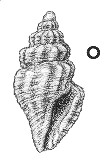
Revised descriptions of New Zealand Cenozoic Mollusca from Beu and Maxwell (1990)

 | Revised descriptions of New Zealand Cenozoic Mollusca from Beu and Maxwell (1990) | 
|
  (Pl. 42o): GS10849, V20/f8572, Devil's Elbow mudstone, top of north face of Devil's Elbow hill, Napier-Wairoa highway, Nukumaruan (GNS) |
Beu & Maxwell (1990): Chapter 15; p. 327; pl. 42 o.
Synonymy: Clathurella abnormis Hutton 1885b, p. 316; Mangilia abnormis; Antiguraleus abnormis, Beu & Maxwell 1990, p. 327, pl. 42o; Propebela abnormis, Beu 2009
Classification: Turridae: Mangeliinae/Oenopotinae?
Description: Small for genus (6.0-6.5 mm high), relatively short and wide for subfamily. Protoconch of 1.5 apparently smooth whorls (microscopically granulous), dome-shaped with low initiation. Whorls with narrow, almost horizontal sutural ramp just below suture, but weakly inflated below shoulder angle, spire clearly stepped; last whorl and canal short, canal open, with oblique anterior end. Sculpture of 3 spiral cords below shoulder on spire and about 12 on last whorl, interspaces filled by several orders of fine spiral threads; crossing prominent, rounded, widely spaced axial costae, about 12 per whorl, without forming nodules (except rounded ones around shoulder angle). Outer lip varicate, markedly opisthocline (as are axial costae), with shallowly concave but obvious anal sinus forming horizontal area of sutural ramp.
Comparison: Propebela abnormis occurs sympatrically in Hawke's Bay Nukumaruan mudstone with the narrower and more narrowly ribbed species P. decepta; other named species (including most modern ones) are taller and narrower and occupy deeper water than P. abnormis. The shell form of the Australian-New Zealand genus Antiguraleus is very similar to that of boreal Oenopota species figured by Bouchet & Warén (1980), and Beu & Maxwell (1990, p. 328) pointed out that there seem to few differences between the protoconchs of Oenopota and Antiguraleus. The taxa closely related to Oenopota have been investigated in detail by Bogdanov (1990), and as pointed out by Beu (2009), it is clear that Oenopota itself has prominent protoconch ridges and is much more nearly similar to Liracraea than to Antiguraleus. However, there are no characters to distinguish Antiguraleus Powell, 1942 from Propebela Iredale, 1918, and Beu (2009) adopted Probebela for all the southern hemisphere taxa previously referred to Antiguraleus.
Distribution: Mangapanian-Nukumaruan; Castlecliffian? "Petane", i.e., hillside north of Petane Pa, north of mouth of Esk River, north of Napier, Nukumaruan (type); widespread and moderately common in Nukumaruan blue-grey siltstone throughout Hawke's Bay and northern Wairarapa; uncommon in Mangapanian and Nukumaruan offshore, soft-bottom facies in Wanganui basin. The records from early Castlecliffian formations of the Castlecliff section, Wanganui, by Fleming (1953) appear to be based on related but distinct species, more nearly similar to P. decepta than to P. abnormis.
Cite this publication as: "A.G. Beu and J.I. Raine (2009). Revised
descriptions of New Zealand Cenozoic Mollusca from Beu and Maxwell (1990). GNS
Science miscellaneous series no. 27."
© GNS Science, 2009
ISBN
978-0-478-19705-1
ISSN 1177-2441
(Included with a PDF facsimile file
copy of New Zealand Geological Survey Paleontological Bulletin 58 in CD version
from: Publications Officer, GNS Science, P.O. Box 30368 Lower Hutt, New
Zealand)